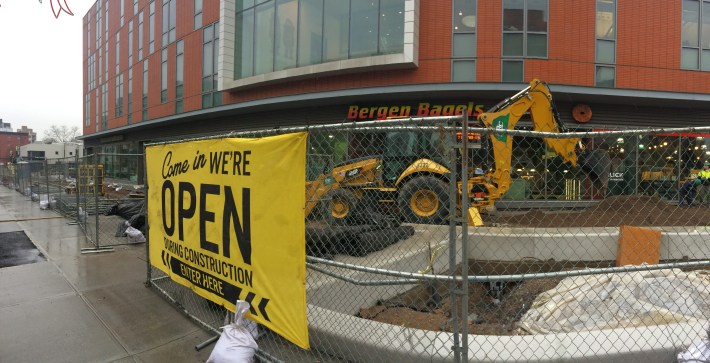It took a while, but the Myrtle Avenue Plaza in Clinton Hill is finally finished.
The project converted two blocks of Myrtle Avenue service road into a pedestrian plaza. It was one of the first public space improvements identified by NYC DOT's plaza program, then became a poster child for the dysfunctional capital construction process at the Department of Design and Construction, which took the better part of a decade to move from design to implementation.
The Myrtle Avenue Revitalization Partnership (MARP), the local business improvement district, conceived of the plaza in 2007. Funded in 2008 in the very first round of DOT plaza projects, design wrapped up in 2011. Yet construction did not begin until the fall of 2014, and once work started, it dragged on until last May.
Of eight long-delayed DDC capital projects highlighted by Streetsblog last January, only two have finished construction: Myrtle Avenue Plaza and the Brooklyn Bridge Gateway, which still has a second phase that DDC does not expect to complete until 2021. Across the city, capital projects overseen by DDC tend to miss deadlines and take years longer than expected, holding up important safety improvements and forcing retail businesses that depend on foot traffic to endure interminable construction-related disruptions.
Originally slated to wrap up in 18 months, construction of Myrtle Avenue Plaza was put on hold just two weeks in, after the discovery of an underground water main. Nine months passed before work got back underway.
Nearby businesses stood to benefit from the plaza, but they took a hit as construction dragged on. Meanwhile, DDC said very little, says MARP Executive Director Meredith Phillips Almeida. All Almeida could pass on to merchants was the occasional update to the project timetable she received from DDC's community liaison.
The uncertainty added another layer to the difficulties merchants were facing.
"I think that it was clear to us why it was delayed, but we weren’t given any preliminary timeline for when work would start up again until very near the time when it did," Almeida told Streetsblog in 2016. "For us as the future manager of the public space, it’s very difficult to build that programming out when the end-point is a moving target.

Later that year, Phillips Almeida managed to get a seat at project coordination meetings. From there she was able to keep merchants informed. Things started to turn around, she says, after she got DDC, DOT, and the Department of Small Business Services to meet directly with affected merchants.
Construction wrapped up in May of last year, although Phillips Almeida said a few minor outstanding items remain.
Phillips Almeida serves as co-chair of the NYC BID Association, which represents 72 BIDs across the city. Many of them have faced similar challenges.
"Obviously we’re not naive," she said last week. "We know that large capital construction projects are challenging and difficult and will have impacts, but if we’re aware of what’s coming down the pipeline, we can do a better job of helping everyone brace for what’s coming and how to be prepared."
The BID Association has pushed DDC to change the way it communicates about projects, and Phillips Almeida said the agency has been responsive so far.
"I’m hopeful that those who come after us might have a better experience, or at least have more tools at the fingertips to figure out how they can advocate for themselves," she said.






